What do you get when you get when you have panel of a social work professor, vice president of a crisis center, psychology researcher, VA psychologist, and computer scientist? You get an amazing panel of folks who are passionate about suicide prevention on social media. On March 31, 2016, at the American Association of Suicidology Annual Conference, this panel presented about the power of social media to engage in a conversation about suicide prevention.
Dr. Jonathan Singer moderated panel that includes Dr. Bart Andrews, Dr. Craig Bryan, Dr. April Foreman, and Tony Wood…
#spsm #aas16 first timer @ social media presentation. @DocForeman @adwww @craigjbryan @BartAndrews @socworkpodcast pic.twitter.com/6kdP49Y3cT
— 0 Home (@janetschnell) March 31, 2016
Here are some of my favorite quotes that were captured…
.@BartAndrews: While #mentalhealth professionals aren't on twitter, the folks we're serving ARE! Something to think about. #SPSM #AAS16
— Hannah (@hannahemoch) March 31, 2016
This has been the “value added” for me as a mental health professional. It is no secret that I have learned a TON from listening to those who have received mental health services. Also the multidisciplinary nature of social media is amazing and this panel embodies that. Tony Wood’s company, Qntfy, is working on a solution where individuals can donate their social media data to better understand suicide prevention. This collaboration was born out of data scientist’s and suicide prevention advocates meeting on social media.
.@craigjbryan when published in a journal, only academics can read that. trying to reach ppl in community, can do this on #SoMe #spsm #AAS16
— Norine Vander Hooven (@norinevhlcsw) March 31, 2016
.@DocForeman : @craigjbryan started putting up videos explaining their studies. One video was seen by 800,000 people. #SPSM #AAS16
— Carl Dunn (@CarlDunnJr) March 31, 2016
.@BartAndrews #SoMe is really storytelling #spsm #AAS16
— Norine Vander Hooven (@norinevhlcsw) March 31, 2016
I enjoy creating content for research that I have ran into on social media. Previous blogs have captured about six pieces of research from individuals having seen a tweet about their research or someone I have “met” via social media. There are so many possibilities to tell your research’s story on social media. The research of Dr. Julie Cerel that demonstrated the impact of survivors of suicide loss from last years’ AAS conference is also an amazing example (see #Not6).
@BartAndrews flips the do no harm paradigm….what harm are we doing by not using social media to engage in suicide prevention #spsm #aas16
— Danny Gladden, LCSW (@dannygladden) March 31, 2016
Again, we have a lot gain as professionals to be on social media. You are missing insights from thought leaders not only in suicide prevention but your area’s of interest. You can often find them accessible and wanting to talk with you about their work on social media. This presentation certainly goes deeper into the many “use cases” of engaging on social media…
.@socworkpodcast: Social media comes with immediate feedback from ALL audiences. It allows us to learn in real time. #SPSM #AAS16
— Chris Maxwell (@chrsmxwll) March 31, 2016
@SPSMChat is a great resource if you want to know about #socialmedia #suicide #research #AAS16 #spsm
— Darcy Jeda Corbitt (@DarcyCorbitt) March 31, 2016
@BartAndrews: #socialmedia isn't #technology it's real people interacting with each other #AAS16 #SPSM
— Darcy Jeda Corbitt (@DarcyCorbitt) March 31, 2016
#SPSM chat 2014 Twitter stats: 46,664 tweets, 109,761,871 timeline deliveries, 3,391 contributors, 8,654,738 reach – impressive! #AAS16
— Carl Dunn (@CarlDunnJr) March 31, 2016
For these insights and much more you can watch the video at the below link…
Have I converted you to social media yet? There are wonderful conversations happening out there with individuals just like these panelist’s. Come on into social media… the water is warm 🙂
